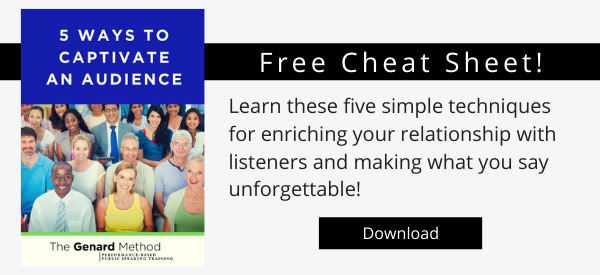Creating effective presentations means remembering that purpose and content are two different animals. Your purpose is what you hope to accomplish in your presentation, while content is what you need to say and show to achieve that purpose.
If you think in these terms your content will always grow organically out of your purpose. (Need to prepare a presentation quickly? Download my cheat sheet "How to Prepare a Speech in 15 Minutes.")
Building Your Speech
But how do you organize your talk once you're clear on your purpose and content? What about a theme that you can build your speech around, for instance, and a logical framework to get there? Theme-based speeches and presentations can be powerful and persuasive. And when they proceed logically, listeners will be able to stay with you every step of the way.
Following are four classic formats for organizing your speech or presentation. Which of them you use depends on your audience, your intended purpose with those specific listeners, and what you want to say to achieve that purpose. Any one of those three variables can change from situation to situation, and your chosen format should also change accordingly.
The four formats:
- Chronological. Does your presentation lend itself to a chronological approach? A talk on handling change, for instance, might take a look back at previous practices then present the reasons why new procedures are necessary. Lectures on historical subjects lend themselves to this format particularly well.
- Problem-Solution. Do your listeners need to be educated about a problem before solutions can be discussed? A problem-solution format is custom made for that situation. If your audience requires a more in-depth examination, you might choose a variation of this format: the Problem-Cause-Solution style of organization.
- Pro-Con (or Alternate Solutions). If on the other hand your audience is already acquainted with the issues, you may elect to skip the discussion of the problem and go right to possible solutions. Now you can talk about the advantages and disadvantages of each approach, i.e., Pro and Con instead of giving your listeners information they already have. A speech on urban gang violence to social workers who deal with the problem every day, for instance, might benefit from a Pro-Con solution rather than the Problem-Cause-Solution format.
- Tell a Story. Audiences love stories as much as any of us, and will listen to them eagerly. Can you organize your presentation around a compelling story? We all have stories to tell—companies and organizations no less than individuals. If you frame your message in the context of a story, with all the drama, conflict, and emotions that people bring to their actions, you will have a very captive audience.
The advantage of using any of these easily created formats is that once you make your decision, your content almost writes itself. Think about any of the methods described above: In every case, the first piece of information delivered by the speaker almost automatically suggests the next bit of content, and so on. You as presenter not only have a format to hang your hat on, but a compelling method to help yourself create the entire presentation!
These four formats, then, offer an efficient and painless way to assemble a presentation. Combine that with a grasp of two other key factors in a successful talk—your audience’s needs and your strategy to meet those needs—and you have an advantage from your first word to your last.


